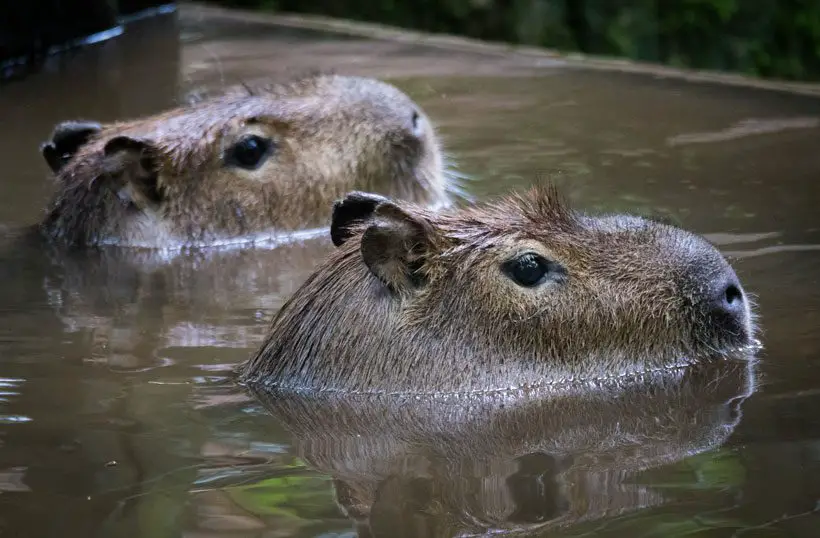Capybara Swimming: Why These Giant Rodents Are Such Good Swimmers?
Watching a capybara swimming can make anyone astonished. They can swim with great skills despite their size. Capybaras can easily dive inside the water and stay there for a long time. As a result, many people question why Capybaras are such good swimmers.
Well, capybaras are such good swimmers because of their physical attributes. They have the necessary facial features for swimming. Moreover, capybaras have strong lungs and hind legs. So they can easily attain a high speed underwater. Besides all these, as capybara habitats are near water, they get habituated to swimming.
This is just the start. There are many more interesting facts about the swimming of capybaras. So keep reading!
Why Capybara Are Such Good Swimmers?
Capybaras are such good swimmers because of their excellent physiques. Capybaras tend to live near water bodies. So they need to swim to be safe and collect food. The mating success of capybaras is also dependent on swimming. As a result, they have attained different physical features that make the task of swimming easy. Let’s see the features without wasting any more time.

Facial Features Are at A High Position
The ears, nostrils, and eyes of the capybaras are high on their face. As a result, they can submerge under water while keeping their sensory organs out of the water. So they feel safe underwater and can swim without much hassle. Moreover, capybaras can also sleep in the water while keeping their nose out.
Webbed Toes
The speed and ease of swimming depend highly on the toe action. And webbed toes are best for moving underneath the water. For this reason, almost all successful swimming animals have webbed toes. Capybaras are no different from that. Their webbed toes offer more resistance under the water. Thus capybaras can swim more speedily.
Strong Lungs
One of the most vital parts of swimming is the lungs. More labor is necessary for moving in the water. Also, a good swimmer must have the capability to hold breath for a long time.
In addition, capybaras are blessed with strong lungs. They can hold their breath for five minutes on average. So capybaras can dive deep under the water and swim for a long time.

Longer Hind Legs
Capybara swimming also benefited from their longer hind legs. The hind legs of capybaras are longer than the front ones. So these legs can produce more strong kicks and forces. As a result, the capybaras can go faster in water.
Wiry Fur
The body of the capybaras is covered with stiff and rigid furs. This type of fur is termed wiry fur. Water does not get stuck in the wiry fur. Rather, it rolls down easily out of the fur. So capybaras do not feel any extra weight of water after swimming. Also, the traction of this fur under the water is helpful for fast action.
Clawed Feet
The clawed feet of the capybaras help them to have more feet. Though capybaras are good swimmers, they can not breathe underwater. They do not have gills which are important for underwater breathing. So they often need to rest on the rocks and muddy places.
The clawed feet come in handy in such situations. They can easily sit on the slipper’s rocks without any issues. Moreover, capybaras can walk on mud and slippery surfaces easily with their clawed feet.

Foldable Ears
One of the interesting capybara facts is that they have foldable ears. They can press their ears flat on their head. This is extremely helpful for swimming. Folding the ears prevents water from getting inside. As a result, capybaras can concentrate fully on swimming.
Habitat
Capybaras are not born with swimming ability. Rather they learn to swim at a young age. As most of the capybara habitats are near water, they must learn to swim. They also spent a big portion of life in the water. Thus they become very skilled at swimming.
Remaining alert is also important for a good swimmer. Capybara remains alert from predators while swimming.
These are the factors that make capybaras such good swimmers. However, there are some other popular queries regarding their swimming. I will try to explore all your doubts on this matter. So keep scrolling!
How Fast Can Capybaras Swim?

Since capybaras are excellent swimmers, they can attain a very high speed underwater. The size of the capybara does not create any hindrance in swimming. Capybaras can swim at a speed of 5 miles or 8 kilometers per hour.
Let us help you to understand this speed practically. The average speed of a paddled kayak is 2 to 3 miles per hour. Moreover, capybaras can cross this speed and go at a faster rate when needed.
Is It Safe To Swim With Capybaras?
Watching the capybaras swimming can be overwhelming due to their cuteness. The scenario might also allure you to swim with them. But it is not suggested to swim with the wild capybaras.

Capybaras are generally harmless and will not attack you. But capybaras will attack you if they feel threatened by you. They will bite you with their sharp teeth.
Moreover, capybaras can be careful about their territory during mating season. So it is better to maintain a safe distance. However, you can swim with a pet capybara. But make sure to be careful with it and observe its body language thoroughly.
If you’re interested in learning more about capybara habitats, you can explore our article on capybara habitat. It provides information about the natural habitat preferences of capybaras, including their preference for aquatic environments and their ability to adapt to various habitats. Additionally, if you want to know more about the behavior and temperament of capybaras, our article on whether capybaras are dangerous discusses their generally non-aggressive nature and provides insights into their social behavior and interactions with humans.FAQs
These are some commonly asked questions about capybaras people ask.
Why do capybaras like to swim?
Capybaras like to swim because of their dry skin. They feel comfortable underwater. Also, a big portion of the capybara’s diet comes from water. They eat various aquatic plants from the water.
Water also keeps the capybaras safe from their enemies. For all these reasons, capybaras like to spend their time in the water.
Do capybaras bite hard?
Yes, capybaras bite hard. Though capybaras are small in size, they have very sharp teeth. Usually, capybaras do not attack humans and other large animals. But they can bite if they are threatened by you. They have strong jaws paired with spiky teeth. So the bite of the capybaras is very hard and painful.
Are capybaras friendly to other aquatic animals?
Capybaras are friendly to other aquatic animals. Tortoise and the capybaras are seen chilling together. Also, predators like crocodiles are often seen swimming in the same water.
Conclusion
Capybaras are very good swimmers because of their physique. They have many necessary and required qualities for becoming the best swimmers. Having strong lungs and longer hind legs has made swimming easy for them. Moreover, wiry fur, facial features at a high position, clawed feet, webbed toes, etc. features are also helpful for their swimming speed.
Besides all these essential physical factors, the habitat of the capybaras has a role in their swimming skills. As they live near water, they must learn how to swim effectively. Swimming is important for capybaras to keep them safe and find food. All these aspects have made them good swimmers.




